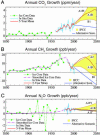Greenhouse gas growth rates
- PMID: 15536130
- PMCID: PMC526279
- DOI: 10.1073/pnas.0406982101
Greenhouse gas growth rates
Abstract
We posit that feasible reversal of the growth of atmospheric CH(4) and other trace gases would provide a vital contribution toward averting dangerous anthropogenic interference with global climate. Such trace gas reductions may allow stabilization of atmospheric CO(2) at an achievable level of anthropogenic CO(2) emissions, even if the added global warming constituting dangerous anthropogenic interference is as small as 1 degrees C. A 1 degrees C limit on global warming, with canonical climate sensitivity, requires peak CO(2) approximately 440 ppm if further non-CO(2) forcing is +0.5 W/m(2), but peak CO(2) approximately 520 ppm if further non-CO(2) forcing is -0.5 W/m(2). The practical result is that a decline of non-CO(2) forcings allows climate forcing to be stabilized with a significantly higher transient level of CO(2) emissions. Increased "natural" emissions of CO(2), N(2)O, and CH(4) are expected in response to global warming. These emissions, an indirect effect of all climate forcings, are small compared with human-made climate forcing and occur on a time scale of a few centuries, but they tend to aggravate the task of stabilizing atmospheric composition.
Figures







Similar articles
-
Soot climate forcing via snow and ice albedos.Proc Natl Acad Sci U S A. 2004 Jan 13;101(2):423-8. doi: 10.1073/pnas.2237157100. Epub 2003 Dec 29. Proc Natl Acad Sci U S A. 2004. PMID: 14699053 Free PMC article.
-
Climate forcings in the industrial era.Proc Natl Acad Sci U S A. 1998 Oct 27;95(22):12753-8. doi: 10.1073/pnas.95.22.12753. Proc Natl Acad Sci U S A. 1998. PMID: 9788985 Free PMC article. Review.
-
Climate change and trace gases.Philos Trans A Math Phys Eng Sci. 2007 Jul 15;365(1856):1925-54. doi: 10.1098/rsta.2007.2052. Philos Trans A Math Phys Eng Sci. 2007. PMID: 17513270
-
Global air quality and climate.Chem Soc Rev. 2012 Oct 7;41(19):6663-83. doi: 10.1039/c2cs35095e. Epub 2012 Aug 6. Chem Soc Rev. 2012. PMID: 22868337
-
Air quality and climate connections.J Air Waste Manag Assoc. 2015 Jun;65(6):645-85. doi: 10.1080/10962247.2015.1040526. J Air Waste Manag Assoc. 2015. PMID: 25976481 Review.
Cited by
-
Nitrogen metabolism in haloarchaea.Saline Syst. 2008 Jul 1;4:9. doi: 10.1186/1746-1448-4-9. Saline Syst. 2008. PMID: 18593475 Free PMC article.
-
Catalytic Nitrous Oxide Reduction with H2 Mediated by Pincer Ir Complexes.Inorg Chem. 2022 Nov 21;61(46):18590-18600. doi: 10.1021/acs.inorgchem.2c02963. Epub 2022 Nov 8. Inorg Chem. 2022. PMID: 36346983 Free PMC article.
-
Intact carbonic acid is a viable protonating agent for biological bases.Proc Natl Acad Sci U S A. 2019 Oct 15;116(42):20837-20843. doi: 10.1073/pnas.1909498116. Epub 2019 Sep 30. Proc Natl Acad Sci U S A. 2019. PMID: 31570591 Free PMC article.
-
Rhodium(I) Pincer Complexes of Nitrous Oxide.Angew Chem Int Ed Engl. 2019 Oct 21;58(43):15295-15298. doi: 10.1002/anie.201908333. Epub 2019 Sep 12. Angew Chem Int Ed Engl. 2019. PMID: 31513331 Free PMC article.
-
Upregulation of the gluconeogenesis pathway was observed by Kluyveromyces marxianus KDH1, mitigating glucose catabolite repression.Food Sci Biotechnol. 2024 Aug 30;34(1):217-225. doi: 10.1007/s10068-024-01670-5. eCollection 2025 Jan. Food Sci Biotechnol. 2024. PMID: 39758715
References
-
- Hansen, J., Ruedy, R., Sato, M., Imhoff, M., Lawrence, W., Easterling, D., Peterson, T. & Karl, T. (2001) J. Geophys. Res. 106, 23947-23963.
-
- Jones, P. D. & Moberg, A. (2003) J. Climate 16, 206-223.
-
- Houghton J. T., Ding, Y., Griggs, D. J., Noguer, M., van der Linden, P. J., Dai, X., Maskell, K. & Johnson, C. A., eds. (2001) Climate Change 2001: The Scientific Basis: Contributions of Working Group I to the Third Assessment Report of the Intergovernmental Panel on Climate Change (Cambridge Univ. Press, Cambridge, U.K.).
-
- Hansen, J., Sato, M. & Ruedy, R. (1997) J. Geophys. Res. 102, 6831-6864.
-
- Ramaswamy, V. (2001) in Climate Change 2001: The Scientific Basis: Contributions of Working Group I to the Third Assessment Report of the Intergovernmental Panel on Climate Change, eds. Houghton J. T., Ding, Y., Griggs, D. J., Noguer, M., van der Linden, P. J., Dai, X., Maskell, K. & Johnson, C. A. (Cambridge Univ. Press, Cambridge, U.K.), pp. 349-416.
LinkOut - more resources
Full Text Sources

